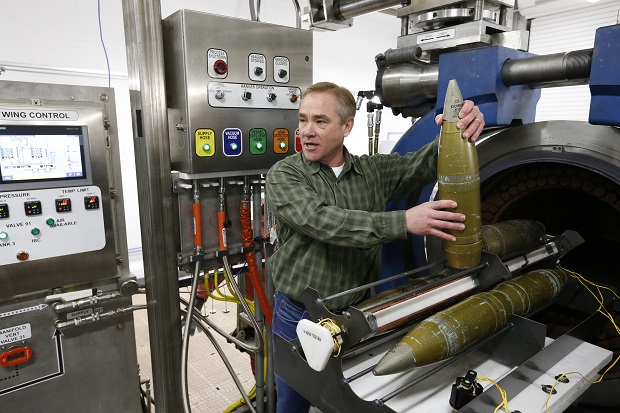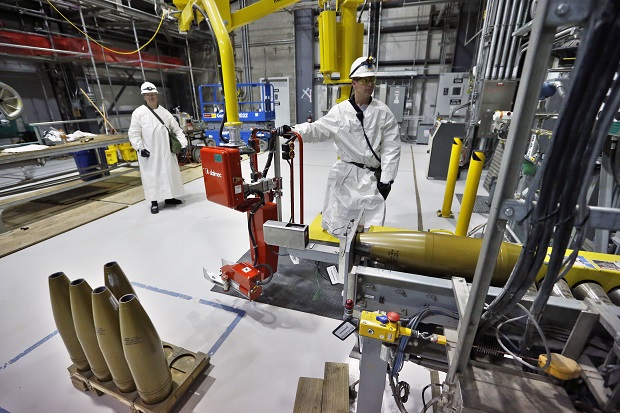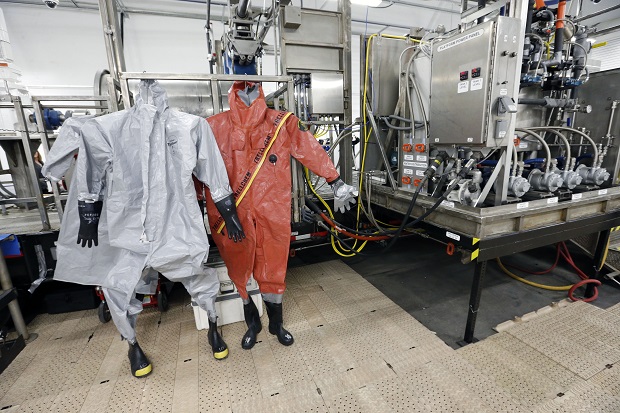US begins destroying its largest cache of chemical weapons

In this file photograph taken Thursday, Jan. 29, 2015, project manager Steve Bird holds an inert 105mm shell as he demonstrates the use of the explosive destruction system used for eliminating leaky or otherwise problematic chemical munitions, inside the Pueblo Chemical Depot, east of Pueblo, in southern Colorado. The United States will begin destroying its largest remaining stockpile of chemical-laden artillery shells Wednesday, March 18, a milestone in the global campaign to eradicate a debilitating weapon that still creeps into modern wars. AP
DENVER, United States — The U.S. Army began destroying the nation’s largest remaining stockpile of chemical weapons Wednesday, using explosives to rip open a container of mustard agent inside a sealed chamber and then flooding it with another chemical to neutralize it.
It was the first few pounds of 2,600 tons of mustard agent that will be destroyed at Pueblo Chemical Depot in southern Colorado, most of it contained in about 780,000 shells.
“Everybody’s really excited, but we’re being cautious, making sure all the procedures are followed exactly,” said Bruce Huenefeld, manager of the first destruction process to get underway at the depot.

In this file photograph taken Jan. 29, 2015, ordinance technicians use machines to to process inert simulated chemical munitions used for training at the Pueblo Chemical Depot, east of Pueblo, in southern Colorado. AP
READ: Secret papers: UK studied chemical weapons buildup in 1980s
Mustard agent can maim or kill by damaging skin, the eyes and airways. It’s being destroyed under a 1997 international treaty banning all chemical weapons. It will take four years to destroy the Pueblo stockpile.
Article continues after this advertisementAnother 523 tons of mustard and deadly nerve agents are stored at Blue Grass Army Depot in Kentucky. Blue Grass isn’t expected to start destroying its weapons until 2016 or 2017, finishing in 2023.
Article continues after this advertisementThe destruction process is safe, officials said.
Most of Pueblo’s stockpile will be dismantled and neutralized in a highly automated $4.5 billion plant built at the depot.
Neutralized
About 1,400 damaged shells and a dozen metal bottles of mustard agent are considered unsuitable for that plant. They’ll be opened with explosives and neutralized in the sealed chamber, which sits inside an airtight structure near the larger automated plant.
The metal bottles contain mustard that was extracted from the shells for testing.
A single bottle was the first container to be opened and neutralized Wednesday. Crews were waiting for the neutralization to finish before draining the chamber, rinsing it and then removing the remains of the bottle.
Once all the bottles are destroyed, crews will start work on the damaged shells, depot spokesman Thomas Schultz said.

In this file photograph taken Thursday, Jan. 29, 2015, protective suits for workers used in chemical munitions destruction hang inside the Pueblo Chemical Depot, east of Pueblo, in southern Colorado. AP
Automated plant
The automated plant isn’t expected to begin work until December or January. Design and construction have taken years, and final testing and training are underway.
Mustard agent is a thick liquid, not a gas as commonly believed. It has no color and almost no odor, but it got its name because impurities made early versions smell like mustard.
The U.S. acquired 30,600 tons of mustard and nerve agents, but it never used them in war. Nearly 90 percent of its original stockpile has already been destroyed, mostly by incineration.
The depots in Colorado and Kentucky are using chemical neutralization because residents and officials expressed concerns about the vapor from incineration.
RELATED STORIES
ISIS using chemical weapons – Kurds
In the know: Organization for the Prohibition of Chemical Weapons